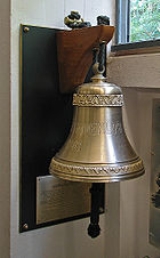
SMS Frauenlob
Encyclopedia
SMS Frauenlob was a Gazelle-class light cruiser in the German Imperial Navy. She was the second ship of that name, after a schooner launched in 1853.
History
Frauenlob was built at A.G. Weser in BremenBremen
The City Municipality of Bremen is a Hanseatic city in northwestern Germany. A commercial and industrial city with a major port on the river Weser, Bremen is part of the Bremen-Oldenburg metropolitan area . Bremen is the second most populous city in North Germany and tenth in Germany.Bremen is...
. On 28 August 1914, shortly after the outbreak of World War I
World War I
World War I , which was predominantly called the World War or the Great War from its occurrence until 1939, and the First World War or World War I thereafter, was a major war centred in Europe that began on 28 July 1914 and lasted until 11 November 1918...
, Frauenlob saw her first action in the Battle of Heligoland Bight, when the British Harwich forces with two light cruisers and 33 destroyers under Commodore
Commodore (rank)
Commodore is a military rank used in many navies that is superior to a navy captain, but below a rear admiral. Non-English-speaking nations often use the rank of flotilla admiral or counter admiral as an equivalent .It is often regarded as a one-star rank with a NATO code of OF-6, but is not always...
Reginald Tyrwhitt
Reginald Tyrwhitt
Admiral of the Fleet Sir Reginald Yorke Tyrwhitt, 1st Baronet, GCB, DSO was a senior officer of the Royal Navy in World War I who commanded light forces stationed at Harwich on the east coast of England during the first part of the war.-Naval career:Tyrwhitt entered the Navy as a cadet in July, 1885...
raided deep into Heligoland
Heligoland
Heligoland is a small German archipelago in the North Sea.Formerly Danish and British possessions, the islands are located in the Heligoland Bight in the south-eastern corner of the North Sea...
Bight. At about 8:00 am Frauenlob and the light cruiser Stettin
SMS Stettin
SMS Stettin was a Königsberg class light cruiser of the Kaiserliche Marine. Laid down at AG Vulcan Stettin shipyard in 1906, she was launched on 7 March 1907, and commissioned on 29 July 1907. The ship served in European waters during World War I, participating in the Battle of Heligoland Bight in...
spotted the British force and opened fire on Tyrwhitt's flagship , rendering her severely damaged and unable to continue the battle. The British cruiser was technically superior to the old Frauenlob, but had just been put into service and was therefore not yet fully battle-ready. When Arethusa turned away, the German cruisers did not pursue her. Frauenlob had received ten hits during the encounter and suffered five dead among her crew. Together with the torpedoboat V 3 and the severely damaged minesweeper T 33 she retreated to the protection of the shore batteries on Heligoland. This saved them from running into Vice Admiral Beatty's
David Beatty, 1st Earl Beatty
Admiral of the Fleet David Richard Beatty, 1st Earl Beatty, GCB, OM, GCVO, DSO was an admiral in the Royal Navy...
battlecruisers that were bearing down upon the battle site and soon afterwards sank the German light cruisers , and and the torpedoboat V 187.
During the Battle of Jutland
Battle of Jutland
The Battle of Jutland was a naval battle between the British Royal Navy's Grand Fleet and the Imperial German Navy's High Seas Fleet during the First World War. The battle was fought on 31 May and 1 June 1916 in the North Sea near Jutland, Denmark. It was the largest naval battle and the only...
Frauenlob was part of the IVth Scouting Squadron under Captain Ludwig von Reuter. In the course of the chaotic night action, the squadron encountered Commodore William Goodenough
William Goodenough
Admiral Sir William Edmund Goodenough GCB, MVO was a senior Royal Navy officer of World War I.-Naval career:Goodenough joined the Royal Navy in 1882. He was appointed Commander of the Royal Naval College, Dartmouth in 1905...
's 2nd Light Cruiser Squadron. The ensuing short, but violent firefight resulted in heavy damage to the British cruisers Southampton
HMS Southampton (1912)
HMS Southampton was a Royal Navy warship that served in the First World War.Southampton was one of the third batch of "Town" class light cruisers, her sister ships were Dublin and Chatham...
and Dublin. However, Frauenlob was hit by a torpedo fired by Southampton and by an artillery shell that ignited ammunition stored near the aft guns. She rapidly listed to port and sank, with only five of her crew of 329 surviving.
Wreck

Kiel
Kiel is the capital and most populous city in the northern German state of Schleswig-Holstein, with a population of 238,049 .Kiel is approximately north of Hamburg. Due to its geographic location in the north of Germany, the southeast of the Jutland peninsula, and the southwestern shore of the...
. Innes McCartney reports that the wreck is upright and largely in one piece. The after mast lies in the sand with the crows nest still in place. There are a number of human skulls and bones visible on the upper deck.

